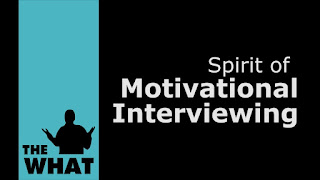As we are about to begin the 2nd quintile of the 21st Century, there are likely few readers unaware of Motivational Interviewing (MI). That said, acronyms like OARS, FRAMES, and other similar pneumonic tools from MI are also likely familiar terms. This familiarity, however, may…and I emphasize may…give rise to a problem when practitioners employ these strategies and techniques of MI in their work. This potential problem results from being proficient in their use but lacking when it comes to purveying the spirit of MI.
Although the use of MI strategies and techniques without necessarily conveying the spirit of MI is better than the traditional “attack therapy” approach used when “confronting” substance use disorders (SUD) years ago, when its strategies and techniques are couched in the spirit of MI, that is when the magic truly happens in brief motivational interactions. As an adage in AA goes, people do not care what you know until they know that you care. This sense of “being cared for” does not automatically result from the use of “technique.” Rather, it results from that more intangible “something else” or “extra” that may best be described as the “aura” that surrounds the use of MI’s techniques and strategies.
This brief essay is an attempt to outline what that “aura” might look like:
· The spirit of MI finds the practitioner less interested with doing something “to” individuals and more focused on doing something “with” them. When a practitioner understands that she or he is a practitioner 2nd and another human being 1st, that is when it becomes possible to truly embrace the individual being interviewed as the expert on her- or himself;
· Related to this, MI is not concerned with “putting in” or “filling up” the individual with what she or he lacks or “needs to know/understand/accept” to change. Rather, the practitioner is interested in “drawing out” what’s what from the individual. To call upon an old counseling 101 reference, Johair’s Window, the practitioner embracing the spirit of MI seeks to help individuals see and then understand those things hidden in the “blind spot” or “unknown-by-the-individual-but-known-by-everyone-else” quadrant;
· When a practitioner creates an environment where these previous two aspects of MI’s spiritual nature are conveyed, “change talk” becomes possible. Remember: Change is an inside job. As Sandra Anise Barnes writes in her book of poetry, Life is the Way It Is, “It’s so hard when I have to, and easy when I want to.” MI is about helping individuals discover that “they want to change” not that they “need to change.” Like in the adage about leading horses to water but not being able to make them drink, remember…we can always salt the oats.
· Practitioner’s embracing the spirit of MI conduct interviews that have more in common with an intercession than an intervention. An intervention is when I confront you to stop—or attempt to stop you—doing what I believe is the wrong thing for you to do. An intercession is when I attempt to present a different perspective from which to look at what you believe are the facts for which you have only one possible interpretation. Borrowing from cognitive behavior therapy, an intercession attempts to help you realize that “thoughts are not facts.” When interceding, I neither stop you nor prevent you from deciding what you will or will not do but I do present you with ways of looking at “your facts” from a different perspective, often employing OARS and FRAMES and other such MI techniques and strategies;
A last thought, for this essay anyway—but by no means the end of all that is involved in capturing the spirit of MI—is remembering to use what is called “person-first” language. This means that practitioners conveying the spirit of MI view and respect the individual with whom they are working as an individual. I work with John Jones who is an individual with an alcohol use disorder, not an “alcoholic”; Mary Brown who has a substance use disorder, is not “an addict.” The language we use conveys messages and meaning to not only the individuals with whom we work but also shapes the way we view those individuals and, consequently, interact with them. Even terms like “client” and “patient,” while professional and respectful, nonetheless establish something of an “us/them” relationship. Remember: MI views the individual being interviewed as the expert on her- or himself and when the individual who is an effective practitioner connects with that individual who is the expert on her- or himself, that is when the magic in counseling truly happens, magic being a euphemism for the spirit of MI.
What do you think?



No comments:
Post a Comment
Thoughtful comments, alternate points of view, and/or questions are welcomed.